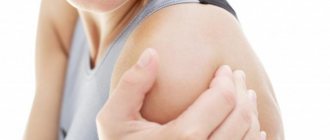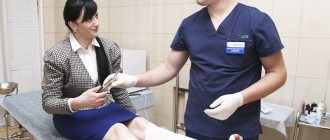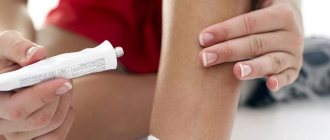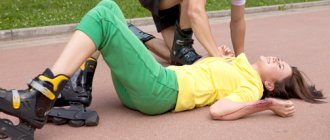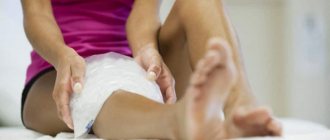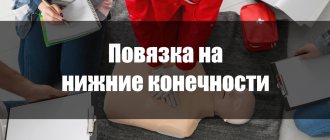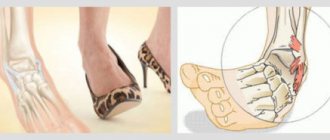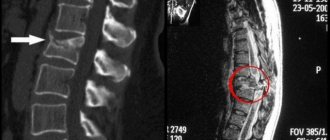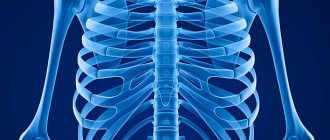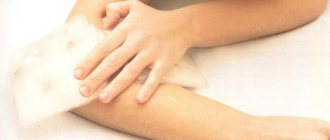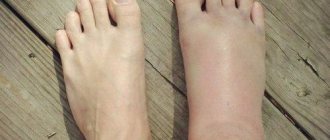This article contains simple rules for providing first aid for bruises, fractures, dislocations, and other injuries. Video lessons are attached to the text.
First aid for injuries is provided in the following sequence:
- We check whether anything threatens us or the victim, for example, a fallen unenergized wire (step voltage), the release of carbon dioxide, excess heat (burn, heat stroke). We stop the effect of the damaging factor, for example, by de-energizing the electrical installation and removing the victim from the fire area.
- We call an ambulance.
- We protect ourselves from contact with the victim’s biological fluids: put on rubber gloves and a plastic bag on your hand.
- We check whether there is consciousness, breathing, pulse, and determine damage. If necessary, we perform cardiopulmonary resuscitation. We carry out the examination in the following sequence: first the head (Careful with the neck!!! There may be a fracture or displacement of the vertebrae!), then the chest, abdomen, back, pelvic area, arms, legs. If the victim is involved in an accident, we always suspect an injury to the cervical vertebrae. We lift, turn over, and carry the victim very carefully so that providing first aid for an injury does not turn into an additional damaging factor.
- If there is bleeding that threatens life, we stop it.
- We fix the broken limb. This is done in the state in which it is: bent so bent, straight so straight, Z-shaped so Z-shaped. We cannot try to give it an anatomically correct shape; we fix it as is. First, we immobilize the fracture site, then the two joints closest to it, for example, in case of a tibia fracture, we fix the knee and ankle joint. It is impossible to bandage the healthy leg to the sick one, because the victim may twitch from pain, and the healthy leg, moving, will injure the sick one.
- If a limb is torn off, after first aid is provided, you need to find it, cool it as much as possible, and upon the arrival of doctors, hand it over to them along with the victim. Ideally, for example, a finger, this is done like this: wrap the tear area with a damp cloth and put the finger in a bag. Then we place the bag with the finger in a bag of cold water so that the water does not enter the bag. Place this bag of water in an ice pack. We tie the necks of the bags all at the same time with one tie. You can mix water with ice in one bag, avoiding direct contact of the tissues with the ice, otherwise they will freeze and nothing can be done. You cannot store severed limbs in the freezer or at subzero temperatures! Modern medical technologies make it possible to replant severed limbs that have been properly preserved. Amputated fingers stored at temperatures above +4 ºС successfully take root if up to 8 hours have passed since the amputation, hands - up to 6 hours, shoulders, feet, legs, thighs - up to 4 hours. If stored at a temperature of 1–4 ºС, this time increases. If the amputation is not complete, you need to cool the part that is “dangling”, for example, apply a bag of water and ice. When a limb is torn off, the bleeding may be slight, since a reflex vasospasm occurs. After applying the bandage, make sure that the limb does not get cold.
Important! If several people are involved in providing first aid for bruises and other injuries, you need to choose a leader whose orders everyone will obey. This will ensure coordinated work and protect the victim from unnecessary jerks, blows, and pain.
Providing first aid for bruises
Most often, bruises occur due to falls or blows with blunt objects.
Signs:
- swelling, bruise, hematoma;
- In case of bruise of internal organs - severe pain.
Providing first aid for bruises
The technique of providing first aid for bruises depends on their location and severity.
- If there is no bleeding or fracture, apply ice or a cold compress to the area of the bruise for 10–20 minutes.
- After the time has passed, remove the cold and apply a tight bandage. Apply cold on top of it for 90–120 minutes.
- If there is a possibility of bruising internal organs (for example, if the victim fell from a height), we urgently hospitalize the victim. At the same time, it is forbidden to drink and feed him.
Stretching
When sudden movements of the joints occur, sprains occur. Injury is often accompanied by damage to muscle tissue. The painful condition of a sprain lasts from a day (for a mild sprain) to 20-30 days (for a severe sprain).
With sprains, despite the pain, the victim is able to move the injured limb.
Symptoms of sprains
To distinguish a sprain from a dislocation or fracture, you need to know the main manifestations of this injury. Most often, articular ligaments are damaged; the symptoms are very similar to a severe bruise. The main difference between sprains is the localization of painful manifestations exclusively in the articular area. The main symptoms of sprains include:
- the appearance of a hematoma;
- severe pain;
- swelling;
- presence of hemorrhage;
- violation of the basic functions of the joint.
First aid for sprains
First aid for various sprains is performed sequentially:
- Fix the limb so as not to aggravate the sprained ligament.
- Apply cold.
- A tight bandage should be applied to the injured limb. This must be done carefully, without disturbing the blood flow. To check, you should leave your fingers unbandaged - their change in color to a lighter color and tingling indicate impaired blood circulation and the need to rewind the bandage.
- If the pain is severe, give painkillers.
After emergency treatment for a sprain, it is recommended to take the victim to the emergency room as soon as possible.
First aid for bruises and sprains
First aid for bruises and sprains is carried out according to the same algorithm:
- apply cold;
- Apply a tight bandage (or an elastic bandage).
The injured limb must be immobilized and not put any weight on it. If a tendon injury is likely, the victim should be taken to the hospital for examination, since after a rupture they do not heal on their own - they need to be stitched in the correct position. If this is not done, disability may occur. In this case, the injured limb must be immobilized.
When starting to provide first aid for a bruise, check whether the person’s pelvic bones are broken.
Dislocation and its complications
Dislocation is a stable displacement of the articular surfaces of bones. It can occur both under the sudden influence of mechanical force and during destructive processes in the joint. In this case, the integrity of the joint capsule (capsule) may be compromised. Sometimes an empty articular fossa is felt.
Signs of dislocation:
- Pain.
- Impaired functioning of the damaged area of the body.
- Change in the contour of a joint or limb length, unnatural position.
- Retraction, displacement of the bone beyond the limits of its physical mobility.
Dislocations come with complications - when, in addition to rupture of the joint capsule, damage to muscles, bones, tendons and nerves occurs, compression or rupture of large vessels.
Providing first aid for a pelvic fracture
Depending on the type of associated injuries, fractures can be open or closed. In the second case, with the development of massive edema, it is difficult to understand what is actually happening.
Signs:
- bruising in the perineal area (internal bleeding);
- severe pain in the pelvis, lower abdomen, back;
- pelvic deformity;
- forced position: the patient bends his legs like a frog to relieve pain.
Providing first aid for pelvic injuries
- We fix the victim in a frog position - with legs bent at the knees. We put something under our knees that will support them.
- If the victim suffered a pelvic injury while sitting (for example, in a car during an accident), a car seat, chair, or something similar is suitable as a splint for immobilization.
- We carry out anti-shock measures: we give painkillers, calm the victim, and ensure his immobility.
It is forbidden:
- try to sit the victim down, put him on his feet, turn him on his side, straighten his legs;
- press on the pelvis to feel the damaged area.
Stretching, its dangers and consequences
A sprain is an injury that occurs when the body moves uncharacteristically. during movement, the amplitude of which exceeds the physiological capacity or volume of the joint. A sprain can be caused by tripping, hitting, or falling. In this case, individual muscle fibers, tendons or ligaments that have been damaged may rupture.
The consequence of a complete rupture of ligaments or tendons will be their further tendency to rupture for the entire period of life (a ligament connects bones, a tendon connects muscle and bone). Training these connective formations is quite difficult compared to training muscles.
Providing first aid for broken limbs
The sequence of first aid for limb fractures depends on the type of injury.
If a fracture:
- open - bones break through the muscle corset, skin and stick out. In addition to the troubles caused by damaged bones and tissues, there is the danger of infection through a wound;
- closed - the limb is deformed, swollen, but the skin remains intact.
By the way. Closed fractures may not be too painful. There are cases where victims endured pain in their leg or arm for several days and only after that went to the hospital, where they were diagnosed with a fracture. So if somewhere something uncharacteristically crunches and hurts, it’s better to get it checked.
When providing first aid for broken limbs, it is important to securely fix them so that the injuries do not get worse.
Providing first aid for an open fracture:
- Check the victim's condition. Perform CPR if necessary. The pain and appearance of the wound may cause the victim to go into shock. Its first phase is characterized by a state of excitement, the victim may rush about, scream, which will cause additional harm to himself and interfere with the provision of assistance. You need to reassure the victim, at least ensure his immobility. First aid for a serious open fracture should be provided promptly so that the shock does not pass into the second phase - inhibition, which is life-threatening.
- Remove excess clothing from the area of injury. At the same time, act without fanaticism. If you break your shin, for example, you don’t need to take off your pants completely; it’s better to cut off the leg. Do not add psychological discomfort to the victim’s physical suffering.
- Stop the bleeding. Treat the skin around the wound with an antiseptic.
- Secure broken bones in the condition they are in. Usually, in general, something smooth and hard is used for this. But if the bone is turned at an angle, you will need a more complex design. First we fix the fracture site, then 2 nearby joints.
- Give the victim pain medication.
- If severe swelling develops, ice can be applied.
It is forbidden:
- set and fold bones independently;
- move a limb;
- wrap the broken leg around the healthy one. The patient will move his healthy leg (in pain, accidentally, in a cramp), so the fracture will worsen.
The algorithm for providing first aid for closed fractures of the extremities is the same, only without caring for the wound surface.
Injuries: first aid and prevention
Trauma (from the Greek trаuma - wound) is damage in the human body caused by the action of environmental factors. Such factors can be mechanical, chemical (damage resulting from exposure to acids, alkalis), thermal (exposure to high or low temperatures). The most common cause of injury is mechanical damage (bruises, sprains, fractures). When they occur, timely and correct first aid is very important.
Among injuries to the musculoskeletal system, bruises are the most common.
At the site of the bruise, a focus of hemorrhage (hematoma), swelling and pain occur, but only a doctor can correctly assess the degree of damage will determine whether the bones, joints and internal organs have been damaged by the bruise . That is why, even with a banal bruise, it is necessary to go to a medical institution, where the victim will undergo an X-ray examination.
First aid for bruises is to create rest, stop bleeding and reduce the size of the bruise . To do this, apply cold compresses, plastic bags or an ice pack to the site of the injury, and apply a tight bandage. The sore leg or arm should be elevated, and to prevent circulatory problems, the bandage should be loosened periodically.
It is important to know that cold is applied to the bruise site during the first 24-36 hours after the injury, then the damaged area should be warmed, which helps to quickly relieve swelling and reduce hematoma . The victim is prescribed warm baths, dry and semi-alcohol compresses, and physiotherapeutic treatment. It is recommended to lubricate the bruise site with anti-inflammatory ointments and creams; for pain, the doctor may prescribe painkillers.
First aid for sprains
is necessary to apply cold to the site of injury (a bubble or plastic bag with ice or cold water) and apply a pressure bandage , securing the well .
If a ligament and damage to the joint capsule occurs, it should be immobilized with a splint, and the victim should be taken to a medical facility .
In case of incomplete ruptures and sprains of the capsular-ligamentous apparatus, conservative treatment is carried out; in case of complete ruptures, surgery will be required.
The restoration of damaged ligaments is a long process ; they heal much more slowly than a broken bone, therefore, when a ligament is sprained it is of particular importance to ensure rest for the joint and fix it in a physiological position.
Tendon damage
Among all tendon injuries, the most common are their ruptures , the danger of which lies in the high probability of disability if improperly treated, therefore the main task of first aid is urgent transportation of the victim to a specialized orthopedic and traumatology department of the hospital.
First aid for fractures
If after an injury a person complains of sharp pain that intensifies with any movement or touch, it can be assumed that a bone fracture has occurred. In such cases the most important thing is to create maximum rest for the injured limb. Each movement can lead to painful shock, loss of consciousness and additional trauma to surrounding tissues, so the victim must be splinted and then taken to a medical facility.
The tire can be made from any available material (sticks, boards, skis, cardboard, bundle of twigs, etc.). When applying it must be observed:
- the splint must fix at least two joints (above and below the fracture site) ;
- Splints should not be applied to a naked part of the body : cotton wool, gauze, or any fabric or clothing must be placed under it;
- The tire should not move, it must be securely fixed.
In the case of an open fracture (outwardly it looks like a bleeding wound with a bone fragment), it is necessary to treat the wound with iodine, brilliant green or alcohol , and then apply a pressure bandage , since blood loss can lead to more serious consequences than the fracture itself. Under no circumstances should you try to correct the position of a damaged bone on your own , much less force its fragments into the depths of the wound ! To alleviate the condition of the victim, you can give him a painkiller, and apply cold to the injury site to reduce tissue swelling.
Injury prevention
The main measures to prevent any injuries are attention and caution, therefore, when going outside (especially on days of alternating positive and negative temperatures), you need to evaluate every step you take.
- Wear only comfortable shoes : a high thin heel and a narrow toe are exactly what you need to avoid falling and getting bruised! Choose stable boots with flat soles or wide heels with a height of no more than 3–4 cm. The sole should be made of non-slip material; if it slips, then before going outside you can stick a thick tape adhesive plaster on it in the toe and heel area.
- And avoid unclean streets and unrolled icy paths . It is better to take the roundabout route where the sidewalks are cleared and paved. Elderly people should not go out in icy conditions without a cane with a sharp tip. It is advisable for pregnant women to go out only if accompanied.
" Hurry up slowly! » The faster you go , the higher the risk of falling. Walk slowly, on half-bent legs, slightly relaxing your knees and leaning on your entire foot, in short steps - this way there is less chance of slipping. It is dangerous to walk on a thin layer of untrodden snow - under it there can be both asphalt and ice.
- Avoid bags with long handles slung over your shoulder; carry them in both hands , distributing the weight evenly.
- Do not wear bulky hoods or hats on your head - they complicate your vision; When exiting a vehicle or going down stairs, lift the tails of your coat or fur coat . Do not keep your hands in your pockets as this may cause serious injury.
- Stay away from the walls of buildings - an icicle or piece of hardened snow may fall from the roof.
- Be extremely careful near the roadway and under no circumstances cross it! The braking distance of cars in icy conditions increases significantly; the driver may simply not have time to brake in time. Do not run after departing vehicles; at a stop, stand away from the edge of the road so as not to slip and get run over by the wheels.
- Avoid drinking alcohol: being intoxicated can cause very serious injuries. In addition, alcohol reduces pain sensitivity, and a person seeks medical help wasting precious time, which leads to complications.
- If you lose your balance , try to group yourself (or at least bend your legs) and relax. Do not point your arms in the direction of the fall - this can break the bones of the hand and forearm; Falls on the tailbone are also dangerous. If a fall is unavoidable, try rolling onto your side to spread the impact.
- After a fall, do not rush to jump up and run on . If you experience pain in the head or joints, swelling, nausea, immediately contact the emergency room. Such symptoms may be due to a concussion or hidden injury.
- Strengthen your bones! Include foods containing iodine, calcium and vitamin D your . The main sources of iodine are fish and seafood (especially seaweed), iodized salt. Calcium is found in milk, cottage cheese, and cheese. But it will not be absorbed without vitamin D, which can be found in fatty fish, eggs, and cereal dishes. In addition, exclude coffee from your winter diet - it washes away calcium.
Remember, the best injury prevention is caution and prudence!
Take care of yourself and be healthy!
Author: Alexey Olegovich Baranovsky – head of surgical
department of the healthcare institution "22nd city clinic"
Providing first aid for spinal injuries
Proper first aid for spinal injuries is very difficult. For example, pulling a victim out of a wrecked car without damaging his neck or back area is not an easy task, especially if the chair was without a headrest. Any careless movement can damage the spinal cord, sever nerves, and lead to disability. It is better for the victim if several people help him.
Providing first aid for spinal injuries
- We fix the victim in the position corresponding to the injury. If he was lying on his stomach, that’s how we lay him down; you can’t turn him over. The optimal position “according to the textbook” is lying on your back on a flat surface (wide board, door, bench). We fix the head with something like a hard collar: rolled up magazines, a hard pillow, rolled-up clothes, a headrest from a car seat, especially when carrying the victim.
- If the victim is in the car and there is no threat of explosion or fire, we leave him in the chair until the rescuers arrive and do not pull him out ourselves.
- We give a strong painkiller.
- We calm him down, don’t allow him to move, and warm him up. To avoid involuntary movements, you can tape his legs to each other and his arms to his body.
It is forbidden:
- sit the victim down, try to get him to his feet;
- try to realign the vertebrae;
- pulling limbs, head.
Dislocation
With dislocations, the location of the ends of the articular bones is disrupted. In some cases, an additional violation of the integrity of the joint capsule occurs. If a dislocation occurs, the area externally takes on an unnatural shape and swells. Immediately after injury, the joint loses motor function. Such injuries are characterized by pronounced pain even in an immobilized state.
Complete dislocation is diagnosed when the articulating bones come into contact after injury. If there is partial contact, subluxation is diagnosed.
Symptoms of dislocations
The following factors indicate an injury such as a dislocation:
- it is impossible to move the injured joint;
- severe pain occurs;
- hemorrhage is clearly visible;
- the limb is deformed;
- swelling appears.
First aid for sprain
First emergency care for sprains includes several stages. It is important to remember the following rules:
- The victim must be laid on his back, the joint fixed with a splint.
- If one lower limb is dislocated, you can strap it to the healthy one if the available means do not allow you to make a splint. The injured arm is taped to the body.
- If a jaw dislocation occurs, a bandage is placed on the victim’s head; it limits the movement of the injured joint. It is recommended to cover your mouth to prevent anything from getting into your larynx.
- A cold compress can be applied to the affected joint to help reduce tissue swelling.
- In case of severe pain, the victim can be given painkillers such as Analgin, Amidoprine or Paracetamol.
To provide qualified assistance, a person with a dislocation must be sent to the emergency room as soon as possible.
If there is no treatment for a dislocation, or a person without proper experience tries to correct it, such actions lead to a deterioration of the condition and various difficulties in further treatment.
General rules
It is necessary to provide assistance to the victim directly at the scene of the incident, and it is important to assess the patient’s condition and the nature of the injury itself. It is difficult for a person without medical education to qualify the degree of damage and the nature of the injury, but anyone can distinguish a closed fracture from an open one.
With a closed fracture, there is a violation of the integrity of the bone inside. They come with offset and without offset. A displaced fracture is more severe because the fragments lose their correct position and move relative to each other. With an open fracture, there is rupture of the skin and muscles, bleeding, pain shock, loss of consciousness and other terrifying symptoms may develop.
Pain relief and proper immobilization are the basis of first aid.
Regardless of the nature of the injury, with open and closed fractures, the person nearby must know the principles of first aid and apply them in practice.
The action algorithm should include:
- Call an ambulance.
- Anesthesia.
- Stop bleeding and treat wounds in open fractures or lacerations.
- Immobilization.
- Fixation.
- Transportation.
All actions performed require a preliminary assessment of the patient’s condition and the severity of the injury.
Transportation
The main and main rule when providing first aid is to call a medical team. Before their arrival, the person must independently monitor the victim’s condition and take the necessary measures to improve his well-being. If it is impossible to call an ambulance, the patient must be taken to the hospital or emergency room independently. When transporting a victim, the following points must be adhered to:
- While sitting, you can transport patients with a fracture of the shoulder, forearm or arm, as well as sprains or dislocations of the upper limbs.
- If there is a fracture of the lower extremities, the person is transported in a lying position on a stretcher, while the leg is broken, it should be raised up, located above the level of the heart.
- Patients with trauma to the skull or internal organs are transported in a supine position.
- Persons with a pelvic or spinal injury are transported in a horizontal position on their back; the surface must be hard and level.
- With rib fractures, transportation is carried out in a sitting or lying position.
Before transporting the victim to the hospital yourself, you need to ensure that the injured area is immobilized. If transported incorrectly, a person’s condition can only worsen, which will affect treatment and prognosis for recovery.
